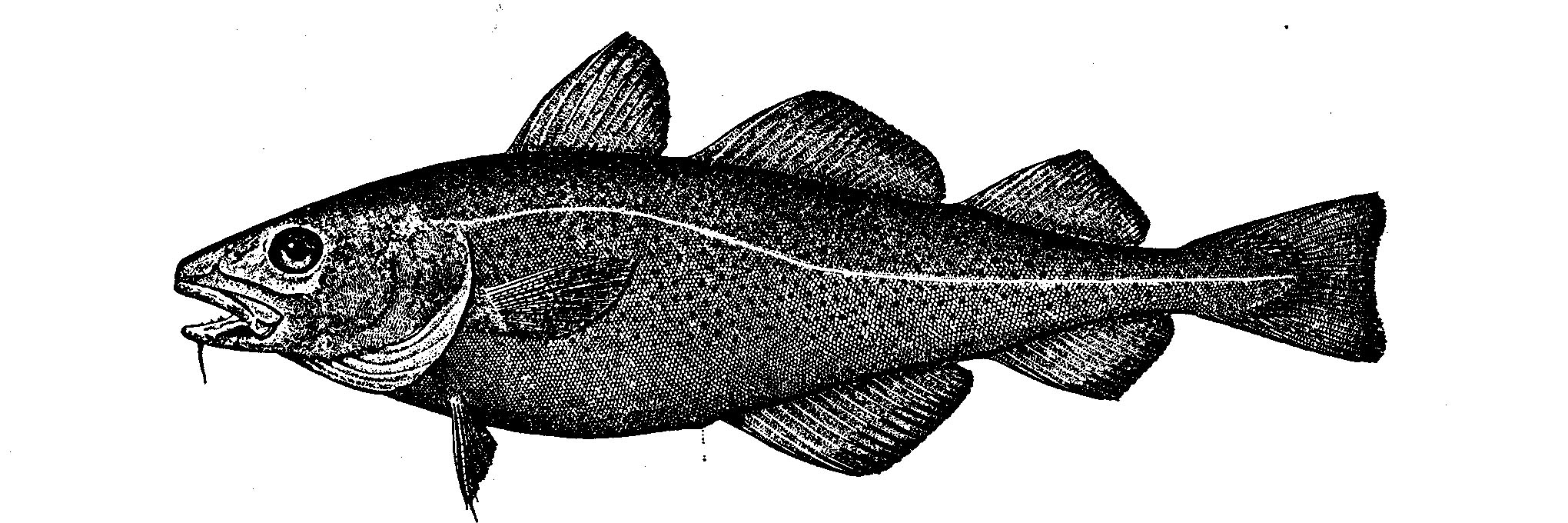Description
Taxonomy
| Kingdom | Phylum | Class | Order | Family | Genus |
|---|---|---|---|---|---|
| Animalia | Chordata | Osteichthyes | Gadiformes | Gadidae | Gadus |
Synonyms
Invasion History
Chesapeake Bay Status
| First Record | Population | Range | Introduction | Residency | Source Region | Native Region | Vectors |
|---|---|---|---|---|---|---|---|
| 1885 | Failed | Contracting | Native & Introduced | Regular Resident | Western Atlantic | Amphi-Atlantic | Fisheries(Fisheries Intentional) |
History of Spread
Gadus morhua (Atlantic Cod) is native to the North Atlantic Ocean, from Nova Zemlaya and West Greenland south to the Bay of Biscay and the NC Coast, and occupies a depth range of at least 0-460 m (Bigelow and Schroeder 1953). This fish occurs only occasionally in coastal waters south of NJ, but can be considered a Chesapeake Bay native (Bigelow and Schroeder 1953; Hildebrand and Schroeder 1928). In lowermost Chesapeake Bay and the adjacent Atlantic, occasional catches were made in March, possibly representing a northward migration of southern populations (Hildebrand and Schroeder 1928).
Gadus morhua is included here, because of attempts to introduce this fish to inshore waters of the Chesapeake Bay. The United States Fish Commission set up hatcheries in New England, with the goal of augmenting populations of commercial fishes. The Chief Commissioner, Spencer F. Baird, encouraged releases of fingerling G. morhua in southern waters, with the idea of acclimatizing young fish to warmer waters and creating new winter fisheries at least as far south as North Carolina (Baird 1880). In 1883, nearly 500,000 G. morhua were released in the Gulf of Mexico near Pensacola FL, and another batch of 500,000 were released in the Chesapeake Bay near Hampton Roads (Baird 1889). At least one more release was made in the Chesapeake. In 1900, 3,000,000 fingerling G. morhua were released in Tangier Sound (Ravenel 1902). These releases appear to have been unsuccessful, and did not alter the status of G. morhua as an occasional wanderer into the Bay (Hildebrand and Schroeder 1928).
References- Baird 1880; Baird 1889; Bigelow and Schroeder 1953; Hildebrand and Schroeder 1928
Invasion Comments
Ecology
Environmental Tolerances
| For Survival | For Reproduction | |||
|---|---|---|---|---|
| Minimum | Maximum | Minimum | Maximum | |
| Temperature (ºC) | 0.0 | 20.0 | 0.0 | 12.0 |
| Salinity (‰) | 35.0 | 5.0 | ||
| Oxygen | ||||
| pH | ||||
| Salinity Range | poly-eu |
Age and Growth
| Male | Female | |
|---|---|---|
| Minimum Adult Size (mm) | ||
| Typical Adult Size (mm) | ||
| Maximum Adult Size (mm) | ||
| Maximum Longevity (yrs) | ||
| Typical Longevity (yrs |
Reproduction
| Start | Peak | End | |
|---|---|---|---|
| Reproductive Season | |||
| Typical Number of Young Per Reproductive Event |
|||
| Sexuality Mode(s) | |||
| Mode(s) of Asexual Reproduction |
|||
| Fertilization Type(s) | |||
| More than One Reproduction Event per Year |
|||
| Reproductive Startegy | |||
| Egg/Seed Form |
Impacts
Economic Impacts in Chesapeake Bay
The unsuccessful attempts to establish resident populations of Gadus morhua (Atlantic Cod) in lower Chesapeake Bay, in 1883-1900, had no known impacts on fisheries.
Economic Impacts Outside of Chesapeake Bay
Gadus morhua (Atlantic Cod), is one of the most important food-fishes in world history, helping sustain large populations in Europe,North America, and elsewhere since the Middle Ages (Bigelow and Schroeder 1953). Attempts to extend the range of Gadus morhua to the southeastern coast of the U.S., through stocking in the Chesapeake Bay and the Gulf of Mexico, (Baird 1880; Baird 1889)., were unsuccessful.
References- Baird 1880; Baird 1889; Bigelow and Schroeder 1928
Ecological Impacts on Chesapeake Native Species
The unsuccessful attempts to establish resident populations of Gadus morhua (Atlantic Cod) in lower Chesapeake Bay, in 1883-1900, had no known impacts on native biota.
Ecological Impacts on Other Chesapeake Non-Native Species
The unsuccessful attempts to establish resident populations of Gadus morhua (Atlantic Cod) in lower Chesapeake Bay, in 1883-1900, had no known impacts on introduced biota.
References
Baird, Spencer F. (1880) Part IV. A. Inquiry into the decrease of food-fishes., In: (Eds.) Report of the Commissioner, United States Commission of Fish and Fisheries for 1878. , Washington, D.C.. Pp. 45-57Baird, Spencer F. (1889) Report of the Commisioner for 1886, United States Commission of Fish and Fisheries, part 17, , Washington, D. C.. Pp.
Bigelow, Henry B.; Schroeder, William C. (1953) Fishes of the Gulf of Maine, Fishery Bulletin of the Fish and Wildlife Service 53: 1-577
2001 FishBase. http://www.fishbase.org
2002-2024 FishBase.(World Wide Web electronic publication).. http://filaman.uni-kiel.de/search.html
Hildebrand, Samuel F.; Schroeder, William C. (1928) Fishes of Chesapeake Bay, Unites States Bureau of Bisheries Bulletin 53: 1-388
Ravenel, William De C. (1902) Report of the United States Commission on Fish and Fisheries for 1900, , Washington, D.C.. Pp.
Remane, Adolf; Schleiper, Carl C. (1971) Biology of Brackish Water, In: (Eds.) . , New York. Pp. 1-210
